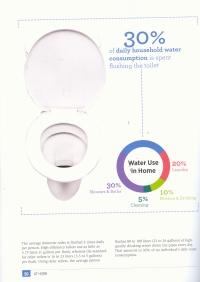| ________________
CM . . .
. Volume xxi Number 15 . . . . December 12, 2014
excerpt:
Be prepared to be surprised and then shocked by the information in this book. Even if you already take short showers and collect water for your plants in rain barrels, this book will both validate your current water concerns and show you a different way to calculate the “water footprint” of our current lifestyle choices. And 99.9% of readers are going to say “I didn’t know that” over and over as they read the fascinating and revealing facts in Your Water Footprint: The Shocking Facts About How Much Water We Use to Make Everyday Products. Using infographics to make his message dramatically clear, environmental journalist Stephen Leahy shows us our “water footprint”, the visible and the invisible water we use to produce the food we eat, the products we buy, and the energy we use. By definition our “water footprint” is the freshwater that cannot be reused or reclaimed at the end of the process. It is water that is used up, gone in terms of ever being usable as freshwater again. With the information about the bottom line costs of our lifestyles choices, we can all make better choices to reduce our water footprint. It is obvious that we are consuming water when cook, wash our clothes and water our plants. Less obvious is the invisible water consumed in manufacturing, energy production, and transportation. Leahy explains the concept of our “water footprint” in an introductory chapter. Quoting sources, such as the World Economic Forum, the International Energy Agency, and the United Nations General Assembly, Leahy helps us realize how complex the calculations are to get to the real cost of our lifestyle choices in terms of water usage. Canadian and American statistics are compared to other countries and world statistics. Leahy then illustrates his message by presenting infographics of the water footprint of 125 everyday products, often with a comparison between products. For example, we learn that the water footprint of one cloth diaper is 15 litres or water while one disposable diaper has a water footprint of 545 litres. The infographic is dramatic enough visually, but the additional text at the bottom of the page makes the net result of the choice of disposable diapers even more “shocking”.
Leahy doesn’t stop with the “shocking” facts about our choices of everyday products. In a chapter titled “The Big Picture”, Leahy uses text, maps, photos and infographs to explain the longer term implications of our current patterns of water usage.
In his concluding chapter, titled “Water and the Future”, Leahy looks at climate change and the unsustainability of using more freshwater than nature can replace. Fortunately, he includes a section on “Water-saving tips” so that we don’t sink into total despair after reading this book. Although none of the tips are new, it is good to be reminded that each of these suggestions can be part of the solution. “Every drop counts, and every person can make a difference.” In writing Your Water Footprint: The Shocking Facts About How Much Water We Use to Make Everyday Products, Leahy has accomplished the nearly impossible. He has created a very credible scholarly text complete with impressive lists of sources and full-text references, and he’s made the information accessible to almost everyone. The only drawback to this book is that it wasn’t written 20 years ago. Every school and library should have this book, and everyone should read it, now. An effective move towards changing our current water-wasteful lifestyle choices would be for some environmentally concerned philanthropist to provide every school and library with a copy of this book. It could be a game changer. Highly Recommended.
Suzanne Pierson is a retired teacher-librarian, currently instructing Librarianship courses at Queen’s University in Kingston, ON.
To comment on this title or this review, send mail to cm@umanitoba.ca.
Copyright © the Manitoba Library Association. Reproduction for personal use is permitted only if this copyright notice is maintained. Any
other reproduction is prohibited without permission.
CM Home |
Next Review |
(Table of Contents for This Issue - December 15, 2014.)
| Back Issues | Search | CM Archive
| Profiles Archive |

 If I could give Your Water Footprint: The Shocking Facts About How Much Water We Use to Make Everyday Products five stars out of four, I would. Buy it. Read it. Share it.
If I could give Your Water Footprint: The Shocking Facts About How Much Water We Use to Make Everyday Products five stars out of four, I would. Buy it. Read it. Share it.